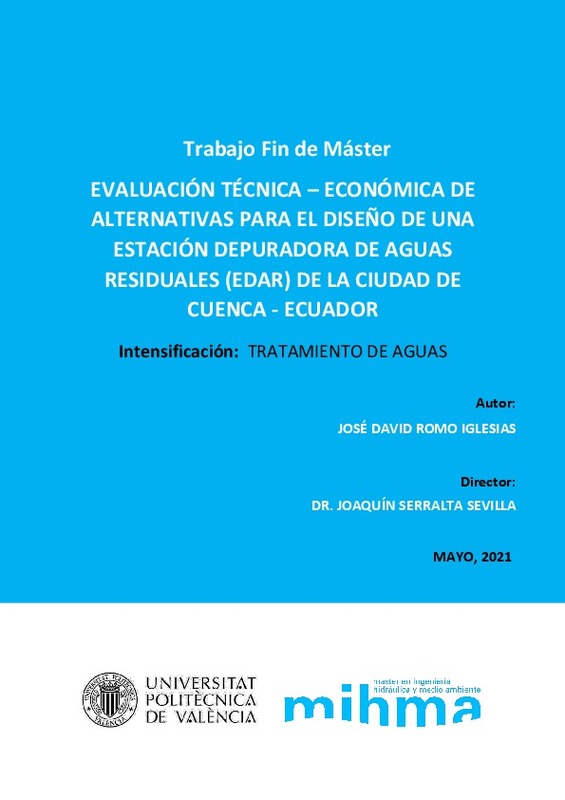|
Resumen:
|
[EN] The city of Cuenca has a population of 614,539 inhabitants, which makes it the third most
populated city in Ecuador. It currently has a wastewater treatment system with a capacity of
1.8 m3 / s that consists of a ...[+]
[EN] The city of Cuenca has a population of 614,539 inhabitants, which makes it the third most
populated city in Ecuador. It currently has a wastewater treatment system with a capacity of
1.8 m3 / s that consists of a lagoon system. However, its constant and accelerated growth
makes it necessary to build a new water treatment station in order to provide adequate
treatment to the wastewater generated in the city.
The new treatment system of which studies began in 2012 should be in operation by 2020,
however, it has not been able to complete its construction phase so far this year. The new
plant will be capable of treating a flow rate of 1.2 m3 / s and consists of a conventional activated sludge system for water purification and an anaerobic digestion system to stabilize
the generated sludge. This plant was also designed solely for the removal of carbonaceous
organic matter and suspended solids.
In order to reduce the impact of the treated discharge on the Cuenca River, this thesis
proposes four alternatives for the redesign of a treatment plant that allows the elimination
of Nitrogen and Phosphorus from wastewater.
As an important reference, this work also starts from directive 91 / 2717CEE (Spanish
Legislation) since its stricter and permissible limits for discharge from urban sewage
treatment plants merit mandatory consideration of a greater removal of nutrients, compared
to Ecuadorian regulations.
In order to design each of the alternatives, this work has started from the characterization of
the city's wastewater, which has been carried out from information collected by the municipal
company ETAPA EP. The aforementioned municipal company maintains a record of the
effluent that reaches the Ucubamba treatment plant. These data have served as preliminary
information for the sizing of the treatment systems proposed in each alternative and to which
typical values expressed in the bibliography have also been added to complete the
information required to make use of the DESASS simulation tool.
The proposed alternatives contemplate nitrogen elimination processes through a nitrification
and denitrification process; while for the elimination of phosphorus, the alternatives consider
the process of eliminating phosphates through a chemical precipitation process and only
alternative three considers a process of biological elimination of phosphorus. An important
factor is that alternative four has a membrane biological process (MBR) that will achieve a
better quality effluent that could be reused.
The main aspects for choosing the best alternative require technical evaluation, the
implantation of the structure on the surface destined for the treatment plant and an
economic evaluation only of the biological reactor and the aspects directly associated with its
operation. In this economic valuation, the price of the pretreatment, primary treatment,
sludge line and required personnel has not been considered.
[-]
[ES] La ciudad de Cuenca, cuenta con una población de 614.539 habitantes lo que la ubica en la tercera posición de las ciudades mas pobladas de Ecuador. Actualmente cuenta con un sistema de tratamiento de aguas residuales ...[+]
[ES] La ciudad de Cuenca, cuenta con una población de 614.539 habitantes lo que la ubica en la tercera posición de las ciudades mas pobladas de Ecuador. Actualmente cuenta con un sistema de tratamiento de aguas residuales con una capacidad de 1.8 m3/s que consiste en un sistema de lagunaje. Sin embargo, su constante y acelerado crecimiento ha visto necesaria la construcción de una nueva estación de tratamiento de agua para poder brindar un adecuado tratamiento al agua residual generada en la urbe.
El nuevo sistema de tratamiento del que se empezaron estudios desde el año 2012 debería estar en operación desde el año 2020, sin embargo, no ha podido finalizar su etapa de construcción en lo que va del año. Esta nueva planta será capaz de tartar un caudal de 1.2 m3/s y consiste en un sistema convencional de fangos activados para la depuración del agua y un sistema de digestión anaerobia para la estabilización de los fangos generados. Esta planta fue diseñada únicamente para la eliminación de compuestos orgánicos y sólidos suspendidos.
En este TFM se aborda el diseño de la EDAR para disponer de una instalación que permita también la eliminación de Nitrógeno y Fósforo de las aguas residuales. Con el propósito de reducir el impacto del vertido tratado sobre el río Cuenca. Como directriz importante se ha partido de la normativa española, ya que sus limites permisibles, mas estrictos, ameritan considerar de manera obligatoria una mayor remoción de nutrientes, frente a la normativa ecuatoriana.
Como propuestas de diseño se establecerán distintas alternativas las cuales serán simuladas en el programa DESASS, como resultado de las simulaciones se obtendrán los requerimientos técnicos de cada alternativa, a los cuales se adjuntará una valoración económica para poder seleccionar la que presente las características óptimas para el adecuado tratamiento del agua residual.
Para poder dimensionar cada alternativa se han usado datos de calidad de agua residual procedentes del registro mensual de la depuradora existente en la ciudad, la que cuenta con valores desde el año 1999 hasta el 2012, año en el cual se diseñó el sistema que esta actualmente en construcción.
[-]
|







